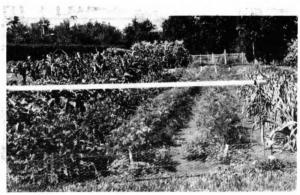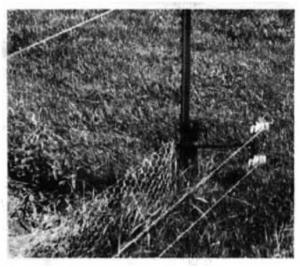1993 - Volume #17, Issue #2, Page #34
[ Sample Stories From This Issue | List of All Stories In This Issue | Print this story
| Read this issue]
Flashing Electric Fence Keeps Deer At Bay
 |
 |
His first step was to put up electric fence. "The problem was that deer can't see the fence wire at night so some times they would plow right through, knocking it over before it had a chance to stop them," he says.
That's when he got the idea of attaching fluorescent lamps to the fence wire that would give a flashing warning to deer as they approach and also let him know at a glance if his fence charger was still work-mg.
"It worked 100 percent last year. I didn't have any damage at all from deer," be says. Smith has two 1/4-acre garden plots as well as a small fruit orchard."
Smith says deer can see the flashing lights on the fence wire from a quarter mile away at night. Most deer stay away from the area entirely t if they do approach they will nudge the wire with their nose and get a strong shock.
He uses standard 40-watt, 4-ft. fluorescent lamps by hanging one end from the fence wire with a clip made out of 1/2-in. wide galvanized metal that wraps around the contact pins on the end of the bulb and hooks over the wire. The other end of the bulb is grounded to the steel fence post. (Smith says it took a lot of experimenting to figure out how to light up the lamp and he's put together a 4-page set of plans that he sends out for a fee).
The fence wire is positioned about 3 ft. above ground. "Four lamps spaced around a 1/4-acre garden kept ail deer out," notes Smith.
He uses a 5,000 volt Blitzer fence charger. Using about 1/2 mile or fence line with - about 20 fluorescent lamps attached, Smith says the charger maintains a near-full charge of 4,650 volts or more. Any solid state, low impedance charger should work.
"I can see two of the fluorescent lamps from a window in the house which is about 500 ft. away. Looking out after dark I can tell at a glance if the fence is still working," says Smith.
He also uses electric fence to keep raccoons out of his garden by positioning one wire about 12 in. off the ground and another 6 in. off the ground. "That has totally eliminated coon damage to sweet corn," he says, noting that he uses small "outrigger" brackets to string the raccoon wires off the same posts used for the wire fitted with the fluorescent lamps.
Contact: FARM SHOW Followup, Harold Smith, 3404 Tipton Rd., Muscatine, Iowa 52761 (ph 319 263-6132).

Click here to download page story appeared in.

Click here to read entire issue
To read the rest of this story, download this issue below or click here to register with your account number.




